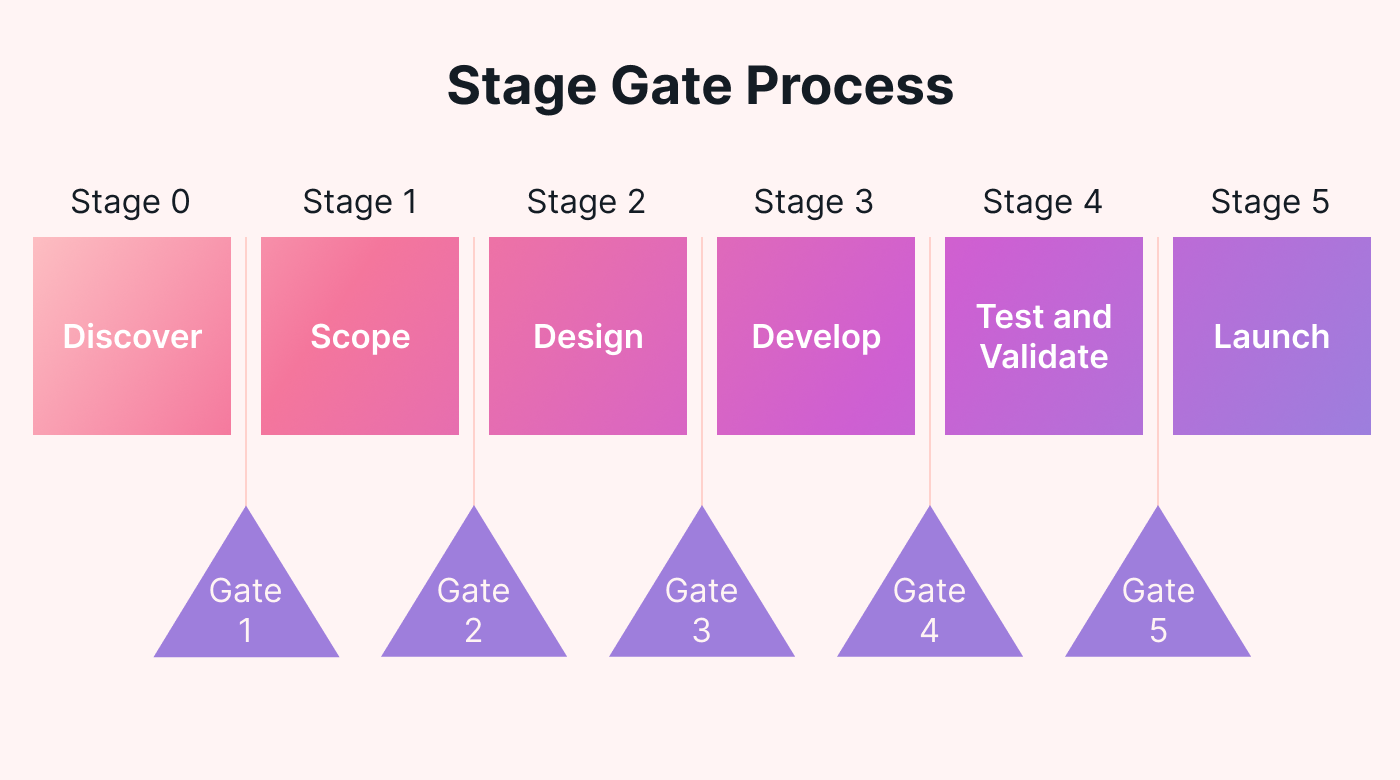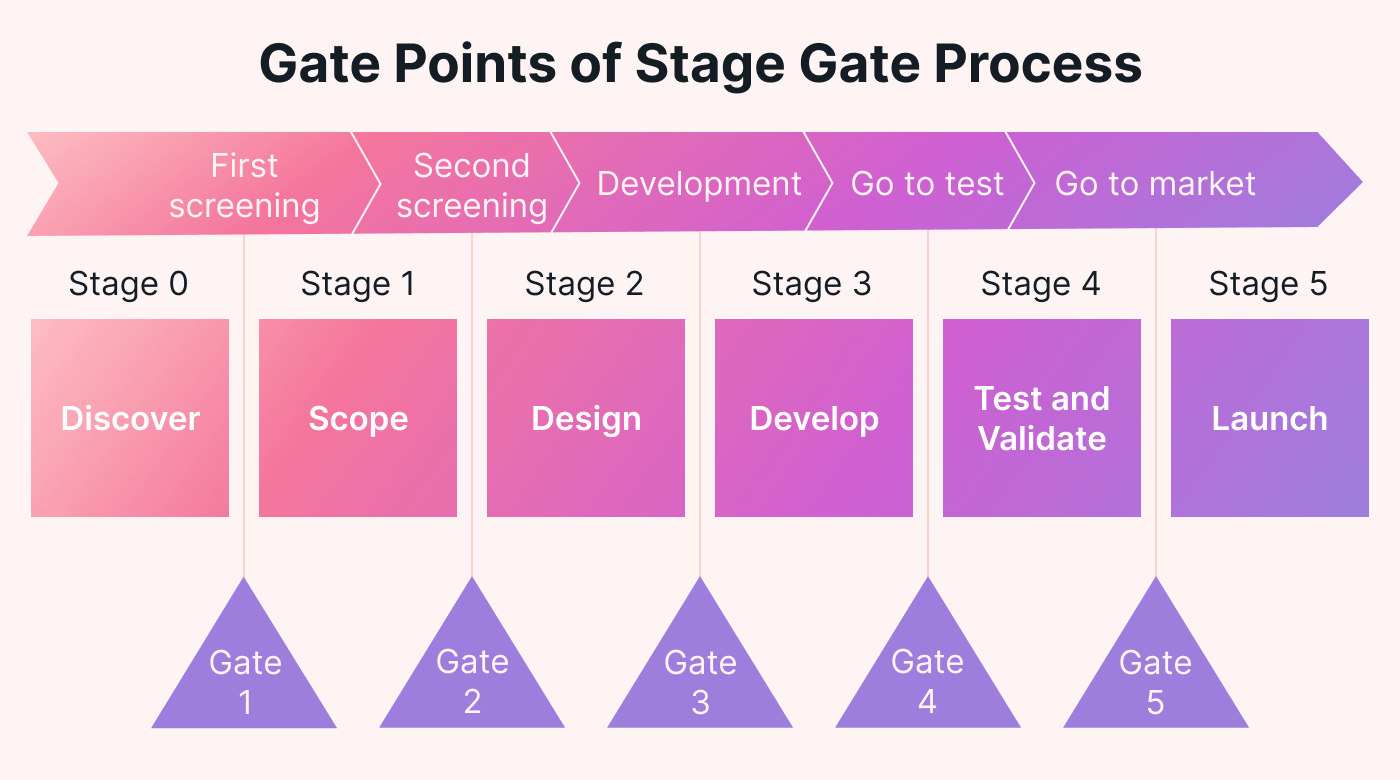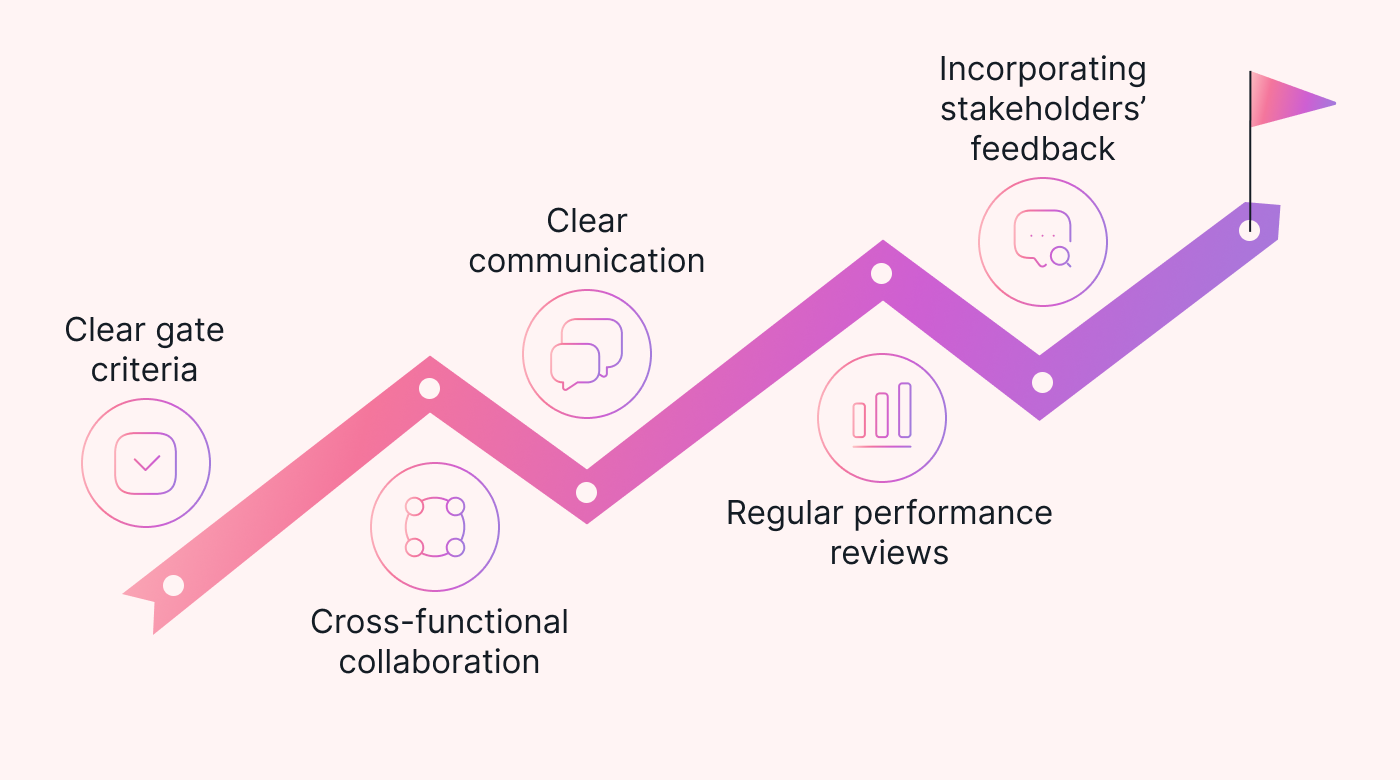Small businesses are always looking for projects to undertake to maintain their growth trajectory. The main challenge becomes: How do they know which projects are feasible and which are not?
According to a recent report, only 31% of implemented software projects could be deemed successful. The rest are either absolute failures or experiencing challenges that could lead to failure.
One way of ensuring project viability is implementing continuous performance assessment. The stage-gate process is one technique that managers and small business owners can use to appraise their projects at different stages.
This article provides a breakdown of the stage-gate process, including the following:
- What is the stage-gate process?
- Benefits of the stage-gate process,
- Stages of the stage-gate process,
- Gate points along the stage-gate process,
- Challenges of implementing the stage-gate process, and
- Effective strategies for implementing the stage-gate process.
What is the stage-gate process?
The stage-gate process is a model for determining the risk or feasibility of a new product idea or proposed product improvement. It comprises figurative gates, which control a project’s progression from one stage to another. A product or improvement can only go to the next phase after satisfying a predetermined criterion for ‘success’ at each gate.
The stage-gate process acknowledges that most product development or improvement projects are resource-intensive. For example, a company developing a new product may require skilled expertise from outside, which may be expensive to contract. A company may also have to lease equipment and spend considerable hours optimizing the proposed deliverables.
Given the anticipated resource implications, companies want to ensure that they only proceed with projects with a high probability of success. The stage-gate process provides a model for determining which projects should be launched, dropped along the way, or sustained to completion.
Benefits of using the stage-gate process
Companies stand to benefit from using the stage-gate process.
Improved project outcomes
The stage-gate process provides a model for identifying which projects are feasible and which are not. Any projects deemed unfeasible do not cross the gates at different stages and are dropped at the earliest stage possible. This reduces dead-end projects.
Ensuring projects remain aligned with organizational goals
Companies only want to undertake projects that contribute to their company goals either directly or indirectly. Businesses can use the stage-gate process to ensure projects remain relevant to their objectives. Every stage and gate provides an opportunity for re-aligning the project to organizational goals.
Encourages collaboration and cross-functional teams
The reviews done after every stage are not a one-person affair. They involve cross-functional teams that assess and decide a project’s fate. Using cross-functional teams increases the chances of product limitations being identified at early stages.
Improves resource utilization and management
Companies often waste many resources on failed projects. The stage-gate process allows businesses to assess their projects’ progress regularly. They can then drop non-performers in the early stages, reducing incurred expenses.
Provides opportunities for continuous improvement
Every gate in the stage-gate process should include a review to identify what went right or wrong. The review findings provide opportunities for improvement in the subsequent stages or the future.
6 Stages of the stage-gate process
The stage-gate process entails six main stages that projects or products must pass through before being delivered to customers or end-users.
 |
Stage 0: Discovery
This is considered the idea-generation phase. Companies usually seek the next ground-shaking idea or discovery that could give them a competitive edge in the market. There is no specific methodology for undertaking the discovery stage. Some businesses get new ideas from market research, customer feedback, or even holding brainstorming workshops.
Stage 1: Scope
This stage involves gathering information about the proposed ideas. Most companies adopt desk research during scoping to avoid spending resources on unfeasible ideas. During scoping, companies may also forecast possible market demand. The undertaken research should provide a basis for defining an idea’s scope–what will be done or covered concerning the concept.
Stage 2: Design
This stage involves preparing a business plan for the proposed idea. An essential task in the design stage is project definition, where the team defines what the idea entails and what ought to be done to achieve the desired outcomes. It also includes product high-level design. It should also include project justification, which makes a case for why the company should pursue the idea.
Stage 3: Develop
Projects progressing to the development stage are usually deemed feasible and make business sense. The cross-functional team performs detailed design and develops the proposed product during the development phase.
Most development stages are resource-intensive. As such, companies often limit development to a few pieces (prototypes). The prototypes provide a basis for planning other related functions like marketing plans or applying for patents.
Stage 4: Test and validate
The developed product or feature should be tested to meet the expected outcomes. There is no one-fits-all test or validation as it depends on the product type and intended use. For example, new products should be tested to ensure they meet industry standards regarding safety and utility. Companies may also plan market research to see how target customers respond to the new product.
Stage 5: Launch
Prototypes that pass the last gate and proceed to the launching stage are deemed ready for the market. The developer should have upscaled their production capacity to match the anticipated market demand. The marketing team may also have launched its promotion campaign to build anticipation for the new product.
Five gate points when using the stage-gate process
An essential aspect of the stage-gate process is its figurative gates. They entail ‘checkpoints’ that projects must go through successfully before proceeding to the next stage.
 |
Gate 1: Early screening
All proposed ideas during ideation and discovery must be screened before proceeding to the scoping stage. It is necessary to sift through and identify the best-fit ideas. During the initial screening, companies may kill ideas for various reasons, including being redundant or not aligned with the organizational goals.
Gate 2: Second screening
Ideas that undergo scoping must pass through the second gate. They may receive a Go or Kill, depending on the reviewed information. For example, ideas whose scopes are difficult to define may be killed or put on hold to be revisited. Conversely, approved ideas move to the design stage.
Gate 3: Development
The third gate offers a boundary between idea design and development. Companies using the stage-gate process must rationally assess the ideas’ feasibility from a business viewpoint. For example, an objective gate should not allow pet projects proposed by senior managers to proceed to the idea development phase.
Gate 4: Go to test
Gate 4 provides an opportunity for assessing how well a product performed during testing and validation. Some products may pass and receive a Go sign.
Conversely, some products may receive a Hold or Conditional Go if they fail in one or two test areas that can be addressed. Products whose utility cannot be validated or do not comply with industry standards may receive a Kill.
Gate 5: Go to market
The last gate checks a product’s market readiness. The product should pass quality and accuracy tests before being released. This gate also assesses a company’s overall preparedness. For example, a product may not go through the gate until a company ascertains the roll-out and marketing campaigns are already in place.
Five strategies for implementing the stage-gate process
The stage-gate process filters out unfit projects to save a company’s resources. However, the process is only effective when done correctly.
 |
Clear gate criteria
Companies should define clearly the conditions or criteria to be met at each stage. Having vague conditions increases the risk of unfit projects slipping through to the next stage. Also, companies should set tough Go or Kill decision points to which they should adhere.
Cross-functional collaboration
Companies or project teams should work together to meet each stage’s deliverables. Moreover, they should work together during the gate reviews to ascertain that only the best ideas or products pass through.
Clear communication
Clear communication goes a long way in ensuring product ideas pass through all the stages successfully until they are launched into the market. The team leaders should also clearly communicate the project goals, gate criteria, and mid-project changes.
Regular performance reviews
Companies and project teams should use the gates to assess the project’s health. The review teams should be objective on whether a project should be sustained or dropped.
Customer driven focus
Many new product ideas are derived from market research and customer feedback. The approved ideas should address the most important customer concerns. Also, project teams should focus on solving the customers’ major problems.
Suitable projects for the stage-gate process
Small business owners with limited knowledge of the stage-gate process may not understand how to apply the process in product development.
New product development
Businesses can use the stage-gate process to vet new product ideas. They should screen the suggested ideas and only approve feasible ones. They can then use the stage-gate process to oversee the product development process and launch process.
Existing product improvement
Companies continuously seek ways to improve their products to match consumer expectations. Businesses can use the stage-gate process to vet product improvement ideas from market research and customer feedback to identify the most feasible ones. They can then use the stage-gate process to ensure the product improvements remain customer-focused.
Software development
The stage-gate process provides a rational model for managing the software development cycles. For example, software companies can use the first three gates to ascertain whether the proposed system is customer-focused, feasible, and makes business sense.
The last gate before launching is also an opportunity to confirm that the software meets end-user expectations.
Change how you assess and identify suitable projects for your business
Senior managers and small business owners often get excited about some ideas and approve product development without first ascertaining whether they are feasible and make business sense. The stage-gate process provides an objective and rational way of assessing and identifying the best ideas for execution.
You can use Motion to organize the stage-gate process for your projects or product development cycles. Motion provides a shared communication and information-sharing platform to facilitate cross-functional collaboration. You can also use Motion to schedule the tasks for each step and assign them to relevant project team members.
Motion’s Calendar feature lets you plan when each phase will start and when the gate reviews will be held. This includes defining the project milestones and marking them as complete when a project passes through a gate successfully to the next phase.
Sign up for Motion’s free trial today!





